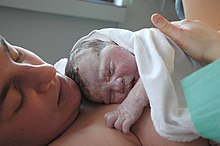Vernix caseosa
Vernix caseosa (also: Fruchtschmiere or Käseschmiere ) is a whitish covering on the skin with which the newborn is born. Their absence at the time of birth indicates transmission .
The fruit smear is formed from the 17th week of pregnancy . It consists of 80% water and 10% lipids , which are formed by the sebum glands of the fetus, which are hypertrophied in relation to the postnatal condition . The remaining portion consists of desquamated epithelial cells of the skin and repelled lanugo hairs and protects the fetus from aggressive components of meconium (Vorstuhl) and the macerating effect of amniotic fluid (amniocentesis).
It should be noted that the skin only developed an (almost) fully developed barrier function at the time of birth. The fruit smear now also contains antibacterial polypeptides such as lysozymes (muramidase), lactoferrin and the like. a. which at least partially protect the fetus from ascending infections during pregnancy and are likely to play an important role in preventing bacterial skin infections ( staphylococci ) in newborns and especially premature babies . Vernix caseosa is now also regarded as a multi-part defense system that consists of polypeptides, lipids and their interactions and - together with the amniotic fluid, which also contains the substances - is seen as comparable to breast milk in terms of its antimicrobial properties . It is now also recommended not to remove the fruit smear after the birth or at least remove it as gently as possible.
Individual evidence
- ↑ a b H. T. Akinbi, V. Narendran, AK Pass, P. Markart, SB Hoath: Host defense proteins in vernix caseosa and amniotic fluid. In: American Journal of Obstetrics and Gynecology . Volume 191, Number 6, December 2004, pp. 2090-2096, ISSN 0002-9378 . doi : 10.1016 / j.ajog.2004.05.002 . PMID 15592296 .

